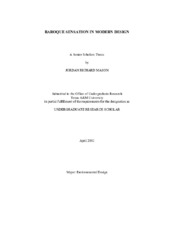| dc.description.abstract | The fundamental purpose of my research stems from the recognition of the fact that modern architectural design and architectural history have been segregated in our current educational system, and my goal is to develop a dialogue that would reunite these two fields. The reason I am looking to the past to inform the present is that so much of what has already been discovered has been lost, forgotten, or ignored, and I want to rediscover those established principles that most successfully connected the individual with the space. It is already an established fact that various architects and designers in the past were able to capture an emotionally evocative sense of atmosphere that had this innate capacity to
resonate with those who encountered those places. It has also been well established in literature that the Baroque era, dating from the late 16th to the early 18th century, qualifies as an age in which the philosophies of design and creative practice converged to produce works that captured this aura of emotion and humanity within a space. So I am going to be narrowing my topic to focus more specifically on the Baroque era. The research begins as an in-depth review of the relevant literature in order to establish the necessary foundation for understanding the human capacity to be affected by the environment. The first phase is an exploration into the fields of psychology and human behavior, looking specifically at what, to our knowledge, makes us feel emotion. The
second phase looks into various architectural principles that relate to the first study, through the examination of spatial atmosphere, sensation, design techniques, and
developmental processes that are characteristic of Baroque architecture. Following the literature review, I propose a methodology for the recording and analysis
of empirical, anecdotal evidence related to the sensory experience of space. This methodology is demonstrated through an extensive series of on-site visits to key
examples of Baroque architecture in which I applied the method to collect the necessary data. Ultimately, the structure of this entire research project allows for the compilation of a template for how to incorporate, what I define as the human connection into the modern
design process. | en |


